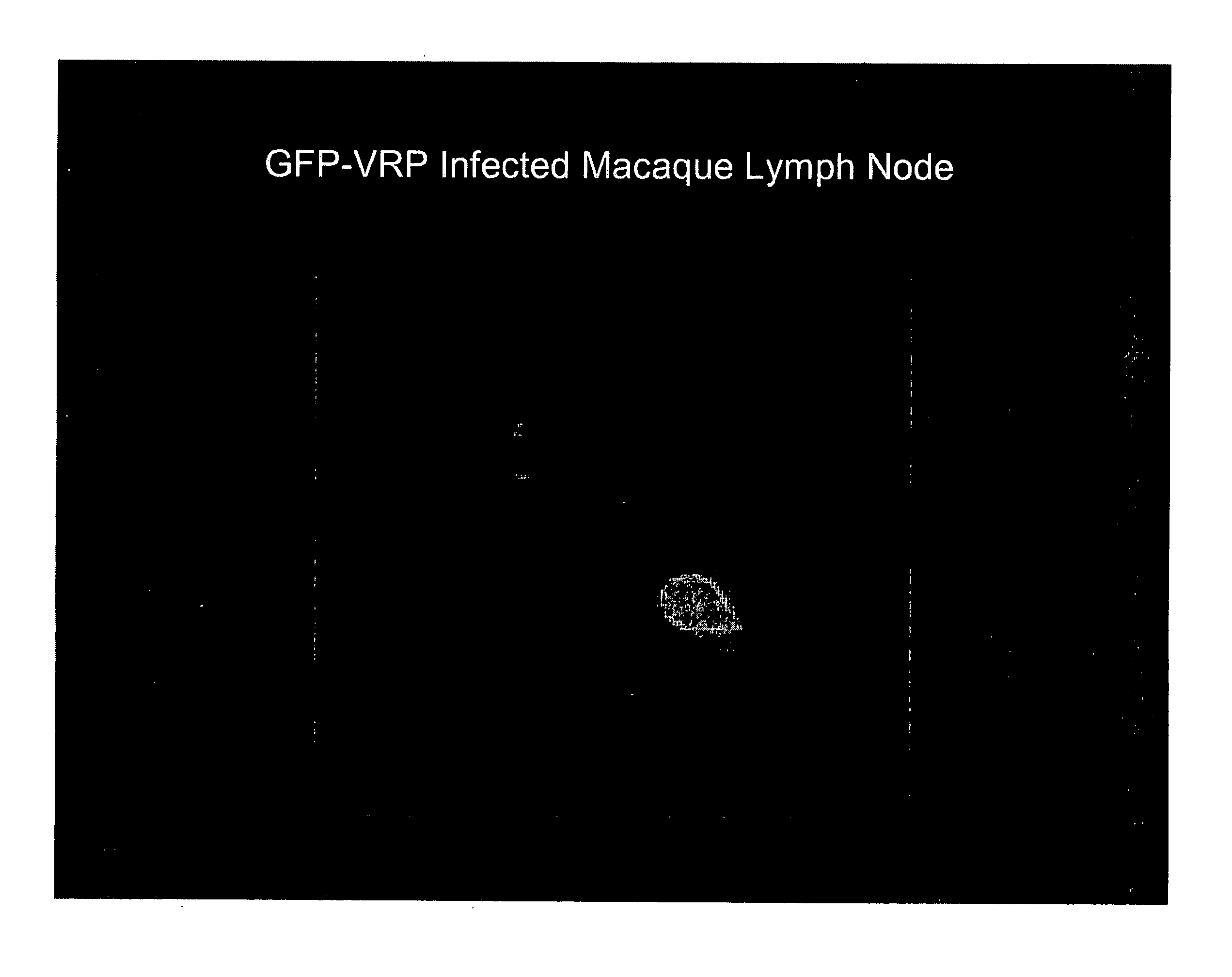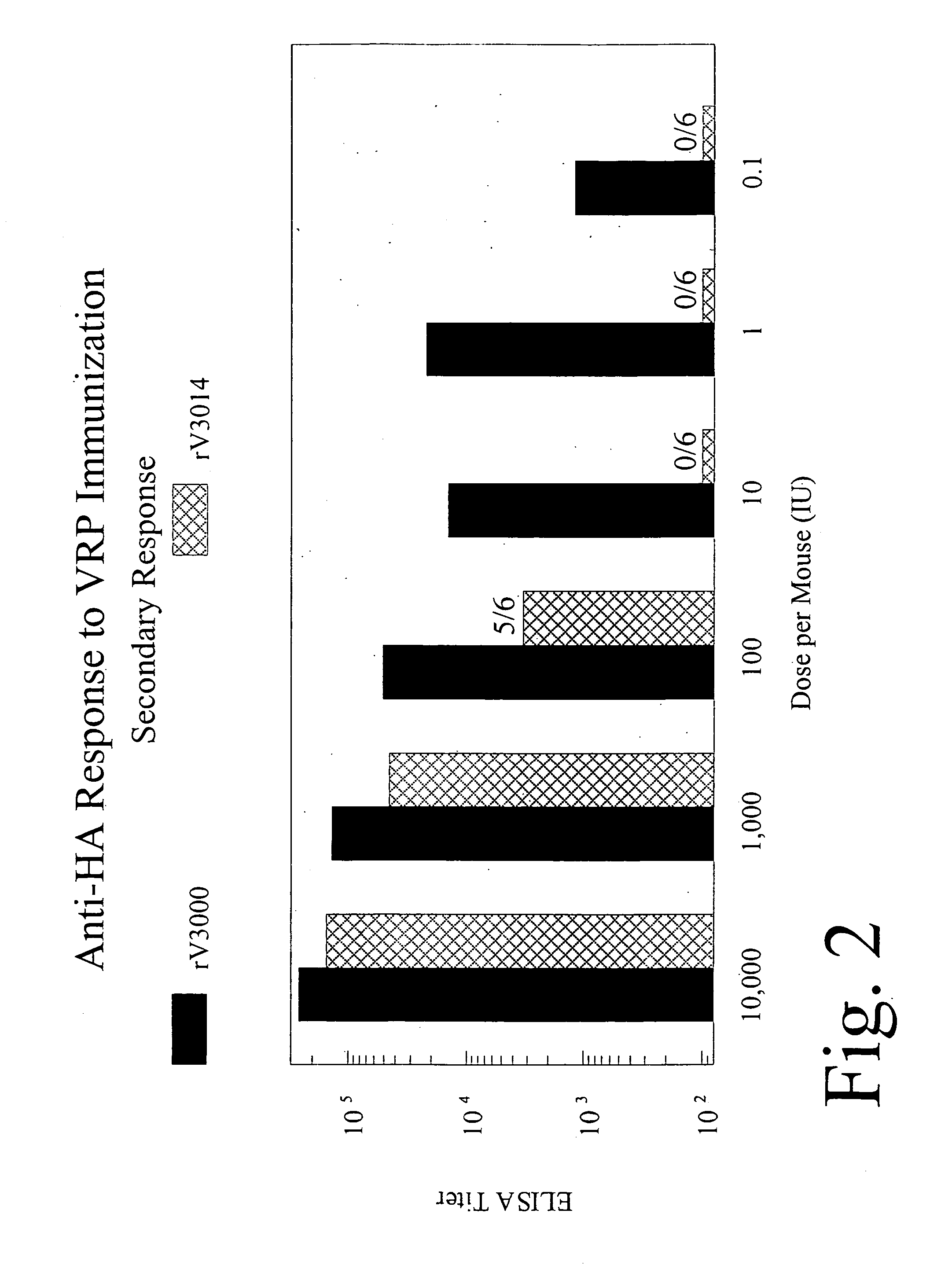Alphavirus vectors having attentuated virion structural proteins
a technology of attenuated virion and alphavirus, which is applied in the direction of dna/rna vaccination, antibody medical ingredients, peptide sources, etc., can solve the problems of potency drop, and achieve the effect of improving immunogenicity and reducing manufacturing costs
- Summary
- Abstract
- Description
- Claims
- Application Information
AI Technical Summary
Benefits of technology
Problems solved by technology
Method used
Image
Examples
example 1
Materials and Methods
[0161] Virus: VEE replicon particles (VRP) expressing either influenza virus hemagglutinin (HA-VRP-3000, HA-VRP-3014, and HA-VRP-3042), green fluorescent protein (GFP-VRP-3000, GFP-VRP-3014, and GFP-VRP-3042), or HIV Clade C gag (HIVgag-VRP-3000, HIVgag-VRP-V3014, and HIVgag-VRP-3042) were prepared as previously described (MacDonald and Johnston, 2000 J. Virology 74:914, Pushko et al. 1997 Virology 239:389). Briefly, RNA transcripts from replicon cDNA plasmids encoding the appropriate heterologous gene were co-electroporated with RNA transcripts from two helper constructs encoding either VEE capsid or VEE glycoprotein genes into baby hamster kidney (BHK) cells. VRP were harvested directly from the culture supernates 24 hr following electroporation and titered on BHK cells. For these studies, VRP were produced using a glycoprotein helper that contained the V3014 attenuating mutations, i.e., an Ala→Thr mutation at E1 position 272, a Glu→Lys mutation at E2 positio...
example 2
Anti-HA Response to VRP Immunization
[0167] The effect of dosage on the primary and secondary response in HA vector-immunized mice was examined. VRP-replicons were administered at 0.1 to 10,000 IU. Four weeks post-inoculation, the mice were bled and ELISA assays for anti-HA response at varying doses of HA-VRP-3000 (wild-type) and HA-VRP-3014 (attenuated) were performed. The results are depicted in FIG. 1. In the same animals at four weeks, a second inoculation of VRP was administered. Four weeks after the second inoculation, ELISA assays for secondary Anti-HA response were performed and are shown in FIG. 2. These results indicate that mutations in the coat protein have a significant effect on the HA replicon induced immune response. At or below a dose of 10 IU per mouse, little primary or secondary response from immunization with HA-VRP-3014 (mutant coat protein) was observed in comparison to HA-VRP-3000 (wild-type). As the vector dosage is increased (100-10,000 IU), response to HA-...
example 3
HIV Clade C Gag-Specific CTL Response in Mice
[0168] CTL response to HIV Clade gag in mice primed and boosted with 100 IU of HIVgag-VRP-3000 is depicted in FIG. 3. Groups of six mice were primed and boosted four weeks after initial inoculation. HIVgag-specific CTL responses were determined according to a standard chromium release assay (Hioe and Frelinger (1995) Mol. Immunol. 32:725-731) one week following the boost at various effector to target (E:T) cell ratios. A Class 1 H-2 Kd restricted Gag peptide (AMQMLKETI) was used as the relevant peptide. An irrelevant H-2Kd restricted HA (influenza virus hemagglutinin) peptide was used as a negative control. The percent specific lysis was calculated as:
[(experimental release−spontaneous release) / (maximum release−spontaneous release)]×100.
Spontaneous release was defined as counts per minute released from target cells in the absence of effector cells, and maximum release was defined as counts per minute released from target cells lysed w...
PUM
| Property | Measurement | Unit |
|---|---|---|
| Electrical conductance | aaaaa | aaaaa |
| Pharmaceutically acceptable | aaaaa | aaaaa |
| Immunogenicity | aaaaa | aaaaa |
Abstract
Description
Claims
Application Information
 Login to View More
Login to View More - R&D
- Intellectual Property
- Life Sciences
- Materials
- Tech Scout
- Unparalleled Data Quality
- Higher Quality Content
- 60% Fewer Hallucinations
Browse by: Latest US Patents, China's latest patents, Technical Efficacy Thesaurus, Application Domain, Technology Topic, Popular Technical Reports.
© 2025 PatSnap. All rights reserved.Legal|Privacy policy|Modern Slavery Act Transparency Statement|Sitemap|About US| Contact US: help@patsnap.com



